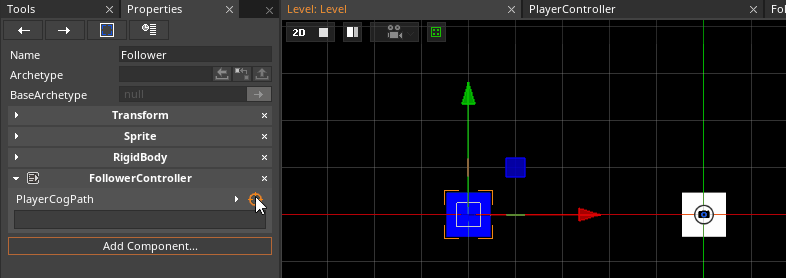CogPaths provide the best way to get a reference to any Cog before running the game. Often you will find situations where a component needs to be aware of a paticular object when the game starts. While CogPaths are not limited to only working at load time this is where they are most useful.
Learning Objectives
- CogPath properties
- Accessing components on other objects
Level Setup
First we will make the ground and player objects.
Create a new project using the {nav icon=clone, name=Empty 2D Project} template
Select : LevelSettings object
Create a NadaScript resource using the Component template template and name it
PlayerControllerUpdate
PlayerControllerscript to the following code block:
class PlayerController : NadaComponent
{
[Property]
var Speed : Real = 5.0;
function Initialize(init : CogInitializer)
{
Zilch.Connect(this.Space, Events.LogicUpdate, this.OnLogicUpdate);
}
function OnLogicUpdate(event : UpdateEvent)
{
var direction = Real3();
if(Zilch.Keyboard.KeyIsDown(Keys.Right))
direction.X += 1.0;
if(Zilch.Keyboard.KeyIsDown(Keys.Left))
direction.X += -1.0;
if(Zilch.Keyboard.KeyIsDown(Keys.Up))
direction.Y += 1.0;
if(Zilch.Keyboard.KeyIsDown(Keys.Down))
direction.Y += -1.0;
this.Owner.RigidBody.Velocity = direction * this.Speed;
}
}
- Command : CreateSprite
- In the
name=Properties Window, icon=window-restore - Rename Sprite object to
Player - Add component : rigidbody
- Add component : boxcollider
- Add component :
PlayerController - Command : PlayGame
- Press
Left,Right,UpandDown

The Follower
- Command : Add resource
- Create a NadaScript resource using the Component template template and name it
FollowerController - Update
FollowerControllerscript to the following code block:
class FollowerController : NadaComponent
{
[Property]
var PlayerCogPath : CogPath = CogPath();
var Speed : Real = 5.0;
function Initialize(init : CogInitializer)
{
Zilch.Connect(this.Space, Events.LogicUpdate, this.OnLogicUpdate);
}
function OnLogicUpdate(event : UpdateEvent)
{
var targetPos = this.PlayerCogPath.Cog.Transform.Translation;
var myPos = this.Owner.Transform.Translation;
var direction = Math.Normalize(targetPos - myPos);
this.Owner.RigidBody.Velocity = direction * this.Speed;
}
}
In the script above the position of the player and the position of the follower are used to calculate a unit vector which defines the 3D direction from the follower to the player. By multiplying it with this.Speed a velocity is defined which can be applyed to move the follower object.
(NOTE)Initializing a CogPath Property: Notice that a CogPath constructor was acutally called in the definition of the PlayerCogPath property. CogPath's are one of the few types that require a manual construction where as Nada value types can have their initial value infered: i.e. var MemberVariable : Real; in this case MemberVariable will have the default type value of 0.
- Command : CreateSprite
- In the
name=Properties Window, icon=window-restore - Set
name=Name, icon=pencil-square-oto:Follower - Add component : boxcollider
- Add component :
FollowerController - Under sprite
- Set
name=VertexColor, icon=eyedroppedto:[0,0,1,1]
- Set
- Under transform
- Set
name=Translation, icon=pencil-square-oto:[-5,0,0]
- Set
Setting a CogPath
- Under
FollowController

This is the CogPath Property GUI. To select which object the CogPath points add you simple click on the Crosshairs and drag them to the target object.

Set
name=PlayerCogPath, icon=pencil-square-oto reference the Player objectPress
Left,Right,UpandDown

CogPaths and Hierarchies
- Command : CreateSprite
- In the
name=Properties Window, icon=window-restore - Set
name=Name, icon=pencil-square-oto:Child - Under transform
- Set
name=Translation, icon=pencil-square-oto:[2,0,0] - Set
name=Scale, icon=pencil-square-oto:[0.5,0.5,0.5]
- Set
- Select : Child object
- Drag and drop it on the Player object object

- Command : CreateSprite
- In the
name=Properties Window, icon=window-restore - Set
name=Name, icon=pencil-square-oto:Parent - Under transform
- Set
name=Translation, icon=pencil-square-oto:[0,2,0] - Set
name=Scale, icon=pencil-square-oto:[0.5,0.5,0.5]
- Set
- Select : Player object
- Drag and drop it on the Parent object object


It can be seen that the Player object moves independently of its parent object do to it having its own RigidBody. However, you may be wondering why the follower no longer goes to the same position as the Player object. If you remember from Hierarchies I, Player object is now a child object meaning its name=Translation, icon=pencil-square-o is measured relative to it's paren object. Since the FollowerController was not changed to use the explicit name=WorldTranslation, icon=pencil-square-o of the Player object, the Follower object moves to the same offset of the Player object as it starts with its Parent object.
- Select the Follower object object
- Under
FollowerController - Examine the text of the
name=PlayerCogPath, icon=pencil-square-oproperty
Notice that the CogPath text has not changed despite the fact that the player hierarchy order has changed.
- Set
name=PlayerCogPath, icon=pencil-square-oto reference the Player object

Notice that the text of name=PlayerCogPath, icon=pencil-square-o changes from :/Player to the correct path of :/Parent/Player. You may be wondering why it worked when the project was run last. When CogPath properties are set they capture a reference at that moment as opposed to waiting for the level to be loaded into the game. When the path to an object targeted by a CogPath changes it does not lose that direct reference to the object, but instead the Path becomes inaccurate. You should not depend on this behavior and you should always reset your CogPath properties to have the correct path when possible. If you wish to learn more about the complex behaviors of the direct cog reference visit the CogPaths Manual Page.
- In the
FollowerControllerscript updateOnLogicUpdateto this code block
function OnLogicUpdate(event : UpdateEvent)
{
var targetPos = this.PlayerCogPath.Cog.Transform.WorldTranslation;
var myPos = this.Owner.Transform.Translation;
var direction = Math.Normalize(targetPos - myPos);
this.Owner.RigidBody.Velocity = direction * this.Speed;
}

Now the Follower object follows the Player object name=WorldTranslation, icon=pencil-square-o correctly.
Related Materials
Manual
Tutorials
Reference
Classes
Commands
Tasks
- T864